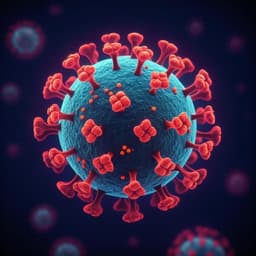
Medicine and Health
Emergence and spread of a SARS-CoV-2 lineage A variant (A.23.1) with altered spike protein in Uganda
D. L. Bugembe, M. V. T. Phan, et al.
Explore the fascinating genomic surveillance study of SARS-CoV-2 in Uganda conducted by a team of experts, revealing the rise of the lineage A.23.1, which might impact vaccine efficacy due to its spike protein changes resembling Variants of Concern. Join the conversation spearheaded by Daniel Lule Bugembe and colleagues!
~3 min • Beginner • English
Introduction
The new severe acute respiratory syndrome coronavirus 2 (SARS-CoV-2) and the associated coronavirus disease 2019 (COVID-19) continue to spread globally, causing over 120 million infections and 2.6 million deaths as of 16 March 2021. Genomic surveillance is critical to track transmission, evolution, and genetic changes that may influence immune escape, particularly as vaccines roll out. A classification system (Pango lineages) monitors SARS-CoV-2 diversification into major lineages A and B and numerous sublineages. Several variants of concern (VOCs)—B.1.1.7 (UK), B.1.351 (South Africa), and P.1 (Brazil)—have shown increased transmissibility and reduced susceptibility to vaccines or therapeutic antibodies.
In Uganda, SARS-CoV-2 was first detected in March 2020, initially among international travellers, with subsequent introductions via truck drivers from neighboring countries after passenger flights were halted. By March 2021, Uganda reported 40,535 cases and 334 deaths. This study aimed to generate and analyze SARS-CoV-2 genomes across Uganda to monitor virus movement and genetic changes, documenting the emergence and spread of a new lineage A sublineage, A.23.1, that became dominant locally and exhibits spike and non-spike mutations of potential functional significance.
Literature Review
The study situates its work within the established Pango lineage system for SARS-CoV-2 genomic epidemiology and references the emergence of VOCs B.1.1.7, B.1.351, and P.1 with documented increased transmission and immune escape. It highlights prior observations of the D614G spike mutation’s effects (infectivity, trimer stability, furin cleavage) and underscores the importance of monitoring spike epitopes. The paper compares mutation patterns across lineages using published VOC genome sets, noting convergent evolution in proteins such as spike, nsp6, ORF8, and ORF9 across VOCs and the A.23.1 lineage.
Methodology
Sampling and sequencing: SARS-CoV-2 RT–PCR-positive samples were obtained via the Central Public Health Laboratories in Kampala from a nationwide catchment, including clinical sites, border crossings, and commercial testing for travelers. Samples spanned 21 March 2020 to 23 January 2021. Nucleic acid was converted to cDNA and amplified using a SARS-CoV-2-specific 1,500 bp tiled amplicon scheme across the whole genome. Libraries were barcoded, pooled, and sequenced on Oxford Nanopore MinION R9.4.1 flow cells per manufacturer protocols.
Assembly and quality control: Basecalling and demultiplexing used Guppy v3.6. Adapters/primers were trimmed with Porechop v0.2.4. Reads were mapped to Wuhan-1 (NC_045512.2) with minimap2-2.17. Consensus polishing employed Medaka v1.3.4. Only complete, high-coverage genomes (>10,000x coverage) were reported; all SNPs and deletions were manually checked against raw reads, with unsupported changes set to N.
Lineage and clade assignment: Genomes were typed using pangoLEARN (pangolin) and Nextclade.
Phylogenetic analyses: For Uganda genomes (n=322), sequences were aligned using MAFFT v7.477, manually checked in AliView v1.27, UTRs trimmed, and maximum-likelihood trees inferred with RAxML-NG v1.0.2 under GTR+I+G4 (model selected via ModelTest-NG v0.1.7), with 100 bootstrap replicates. Trees were visualized in FigTree v1.4.4 and rooted at the A/B lineage split. For combined Ugandan and global A.23/A.23.1 genomes (Uganda n=191; global A.23 n=8, A.23.1 n=38 retrieved 12 March 2021), the same pipeline was used and trees rooted on A.23.
Protein domain change profiling: Profile HMMs were generated from the first 65 lineage B genomes by translating all three forward ORFs, slicing into 44-aa windows overlapping by 22 aa, clustering with uclust (usearch11.0.667), and annotating via BLASTP against NC_045512. Query genomes lacking ambiguities were scanned with HMMER v3.3.2 (hmmscan) against this database using E-value ≤ 1e-4. Domain bit-scores were normalized (x/xmax) and 1 − mean normalized bit-scores were plotted across the genome to visualize protein changes. This analysis was applied to A.23/A.23.1 and to VOC sets (B.1.1.7, B.1.351, P.1).
Statistics and study design: No a priori sample size calculation; experiments were not randomized and investigators were not blinded.
Key Findings
- Sequencing output and coverage: 322 complete high-coverage genomes were generated from 39,424 reported infections (0.8% of cases) between March 2020 and January 2021.
- Emergence and dominance: Lineage A.23 emerged during prison outbreaks in Amuru and Kitgum in August 2020, defined by spike changes F157L, V367F, Q613H. By September–November 2020, A.23 became the major lineage nationwide. Sublineage A.23.1 (additional spike P681R) was first detected in late October 2020 and accounted for 88% of genomes in December 2020 and 100% in January 2021 (90% of genomes across Dec 2020–Jan 2021, 102/113).
- Geographic spread: A.23.1 was detected in 26 countries outside Uganda. A.23 was first seen in Uganda in August 2020, and later in the US (October) and in Kenya and Rwanda (December). A.23.1 appeared outside Uganda in England and Cambodia (late November) and Rwanda (early December). International flights from Uganda resumed on 1 October 2020.
- Introduction routes: Early diversity reflected introductions via international travel; after flight restrictions, truck drivers served as a key introduction route, with genomes from truck drivers often basal to community clusters. POEs bordering Kenya showed predominance of B.1/B.1.393, while POEs bordering South Sudan/Tanzania showed both A and B.1 lineages.
- Spike mutations of concern: A.23.1 spike harbors multiple S1 changes including P681R adjacent to the furin cleavage site (potentially enhancing cleavage/fusion), Q613H (analogous to D614G effects), and NTD changes (e.g., P26S, R102I). E484K and N501Y were observed in some A.23 genomes (Adjumani, Nov 9–11, 2020), and E484K was found in an A.23.1 genome from Kampala (Dec 11, 2020).
- Non-spike changes and convergence with VOCs: A.23.1 encodes changes in nsp3 (E95K), nsp6 (L98F, M86I, M183I), ORF8 (L84S, E92K), and ORF9/N (S202N, Q418H), paralleling altered proteins in VOCs B.1.1.7, B.1.351, and P.1. Notably, nsp6 changes in A.23.1 occur in/external to loop regions analogous to the 3-aa deletion (106–108) seen in VOCs.
- Additional observations: A G27870T mutation causing early termination of ORF7b (E39stop) was detected in Tororo community cases (late December 2020). Phylogenetics support A.23 evolving into A.23.1 with A.23 genomes basal to A.23.1 clusters.
Discussion
The study documents the local emergence, evolution, and rapid dominance of SARS-CoV-2 lineage A.23.1 in Uganda, a pattern mirrored in neighboring Rwanda and reminiscent of the expansion of VOCs (B.1.1.7, B.1.351, P.1) elsewhere. Despite differing exact mutations, A.23.1 shares functional themes with VOCs: alterations in spike regions critical for ACE2 engagement, the furin cleavage site (P681R), and the 613/614 position associated with enhanced spike multimer formation. Convergent changes in nsp6 suggest possible modulation of autophagy-related replication niches, while recurring changes/deletions in ORF7/8/9 imply these accessory proteins are frequently dispensable or adaptively tuned during human infection. The detection of E484K and N501Y in some A.23/A.23.1 genomes raises concerns regarding immune escape and therapeutic efficacy. These findings underscore the need for ongoing genomic surveillance and functional assessment of the observed mutations, particularly regarding vaccine performance against A.23.1.
Conclusion
This work provides a comprehensive genomic epidemiology of SARS-CoV-2 in Uganda from March 2020 to January 2021, identifying the emergence of lineage A.23 and its evolution into A.23.1, which rapidly became dominant and disseminated internationally. A.23.1 exhibits spike and non-spike changes with parallels to known VOCs, indicating convergent evolutionary pressures during human adaptation. The study contributes actionable insights for surveillance priorities and highlights the importance of evaluating vaccine and antibody susceptibility to A.23.1. Future research should include expanded sequencing coverage in East Africa, functional studies of nsp6/ORF8/ORF9 alterations, and neutralization assays to quantify vaccine and therapeutic effectiveness against A.23.1 variants bearing mutations such as P681R and E484K.
Limitations
- Sequencing coverage was limited to 322 complete genomes (~0.79–0.8% of reported cases) due to resource constraints, reagent supply issues, travel restrictions, and staffing limitations during the study period.
- Sampling was not randomized or blinded, and not all positive cases could be sequenced; sentinel/national surveillance density is lower than in Europe/North America, potentially biasing lineage frequency estimates and phylogeographic inferences.
- Alternate evolutionary scenarios cannot be excluded given regional under-sampling (e.g., A.23.1 emergence in a neighboring, unsampled country followed by importation into Uganda).
- Sequencing technology (MinION) has known error profiles; however, high coverage, manual curation of variants, and reporting only complete high-coverage genomes were used to mitigate errors.
- No statistical power calculation was performed; experiments were not randomized, and investigators were not blinded.
Related Publications
Explore these studies to deepen your understanding of the subject.







